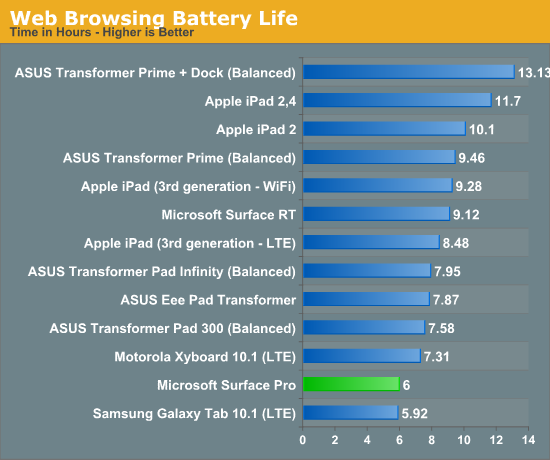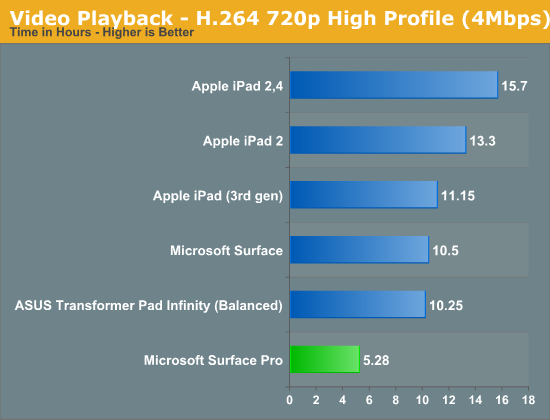Microsoft Surface Pro Review
by Anand Lal Shimpi on February 5, 2013 9:00 PM ESTBattery Life: The Downside
Despite having an integrated 42 Wh battery (similar in size to the 3rd and 4th gen iPads with Retina Display), battery life is a real sore spot for Surface Pro. Haswell is really designed to drive platform power down to very low levels, which should help close the gap between ARM/Atom based tablets and Core based tablets. Unfortunately, Haswell for tablets won’t hit until the third quarter of this year, which forced Microsoft to use Ivy Bridge.
In our tablet benchmarks, I never saw Surface Pro break the 6 hour mark on a single charge. In most cases I’d expect to see 5 - 6 hours out of Surface Pro in light, tablet usage. Video playback was especially disappointing as Surface Pro managed to use more power here than during our web browsing battery life test. I suspect this might have to do with the relative power efficiency of Ivy Bridge's video decoder. It'll be interesting to see how Haswell does in this department.


I also put Surface Pro through some of our new notebook battery life tests for 2013, and here it didn’t fare too bad. I only have Acer’s 13-inch S7 to compare to but Microsoft managed 3.85 hours in our medium workload compared to sub-3 hours for the larger Ultrabook:
| Windows 8 Notebook Battery Tests | ||
| Battery Test | Acer Aspire S7 (13-inch) | Microsoft Surface Pro |
| AnandTech 2013 Light | 4.00 hours | 5.2 hours |
| AnandTech 2013 Medium | 2.88 hours | 3.85 hours |
This is easily the biggest disappointment with Surface Pro. You just won’t get the all day battery life you do with an ARM based tablet out of this design. I expect Microsoft will have a solution to this problem with Haswell, but not until the end of the year.
Charging
Surface Pro retains the same large, magnetic power connector as Surface RT. In fact, Surface RT’s power adapter will still charge Surface Pro. The Pro model does however come with its own 48W adapter. It’s a nice looking, but large and still fairly traditional two piece power supply (brick + detachable wall cable). There’s no sophisticated cable management other than a tiny hook to help keep the device end of the cable together. One neat feature is the power adapter does feature an integrated USB port for charging your smartphone.
Under max charging load the power supply will draw around 27W at the wall. Microsoft included a 48W unit in order to be able to charge and power the device without slowing down charge time. It took me 2.692 hours to charge Surface Pro from completely empty to 100% with no additional power draw at the wall. The quick charge time is pretty nice and about the only reprieve here when talking about Surface Pro's battery.
I did notice something odd with the first power supply Microsoft sent me. When charging through my power meter, I picked up some interference in the capacitive touch screen itself resulting in around 10% of my taps not being recognized. Microsoft supplied another power supply that seemed to resolve the issue.













228 Comments
View All Comments
powerarmour - Thursday, February 7, 2013 - link
x86 compatibility isn't a deal breaker at all, not any more.Even Microsoft are pushing for cross compatible RT apps. And there is a huge amount of software out there already for Android and iOS.
oolzie - Wednesday, February 6, 2013 - link
I do think you should revise it to point out that you can and are probably expected to use the stylus when using desktop apps without a kb/m combo or cover. I haven't used the Pro yet, but I have used another Win8 tab with stylus and using the stylus as a finger removed nearly all of the frustration of desktop navigation in tablet mode.Jhlot - Wednesday, February 6, 2013 - link
If this thing had a a dock connector/stand for when business types are at the office it would be the killer business PC to have and they would move a ton a units to big corporations. I cannot believe Microsoft failed to include a docking solution.....huge miss MS, failure of imagination and to really innovate competitively.andrewaggb - Thursday, February 7, 2013 - link
I totally agree. And sure the dock/device can run 2 external displays (even if you have to disable the built in one).And next time support WIDI.
andrewaggb - Monday, February 11, 2013 - link
well, I discovered thesehttp://www.displaylink.com/shop/docks
USB 3 docks with dual monitor connectors (different vendors have different combinations including vga,displayport,hdmi,displayport)
Also have built in audio, usb hub, and gigabit ethernet. Some reviews seem ok. Not awesome for video and gaming (though they say it's ok), but sounds like it would be totally fine for work related tasks and you can use the tablets internet or external display for video and gaming if necessary.
So I guess I can scratch the no dock/multi-display issues off my issues list. And now I'm seriously considering it again.
eg
HP 3005pr USB 3.0 Port Replicator
http://www.fujitsu.com/uk/products/computing/pc/ac...
andykins - Wednesday, February 6, 2013 - link
That core i5 costs $225. You can get a whole Nexus 7 for that and still have change left over. ARM SOC's cost like $30, tops? Not disagreeing with you but there's more to it.LetsGo - Wednesday, February 6, 2013 - link
"ARM Processor inefficient compared to Intel's Core architecture.?"What planet do you live on, ARM processors have enabled normal people to enjoy computing, Intel would have never enabled this because the margins were not big enough for them.
When Arm gets its 64bit architecture on Intel is toast.
denman - Wednesday, February 6, 2013 - link
Great review! Really happy you paid more attention to screen and pen overview. Would you mind to post the calibration profile (file) somewhere?Imaginer - Wednesday, February 6, 2013 - link
That this thing is a boon for anyone that can draw, create, and do things with the pen. It has pressure sensitivity and by this review, also tilt. Sources elsewhere says it has an eraser and a right button click. I don't know about you but having a digitizer, touchscreen in a power of an ultrabook with the dual functionality of a tablet and a ultrabook? And under or around $1000? An intuos digitizer tablet easily eats $300 if not some. So all in all, you are all nay sayers and not seeing the true potential of this. This is never meant to be a simple toy.guidryp - Wednesday, February 6, 2013 - link
I like Anands Technical analysis of chip features.But when it comes to usability I really question positive reviews of this form factor that is neither that good as a tablet (Heavy, goofy 16:9 ratio, hot, heavy, weak battery life) and not that good as a laptop (cramped keyboard, small screen, awkward hinge/kicstand).